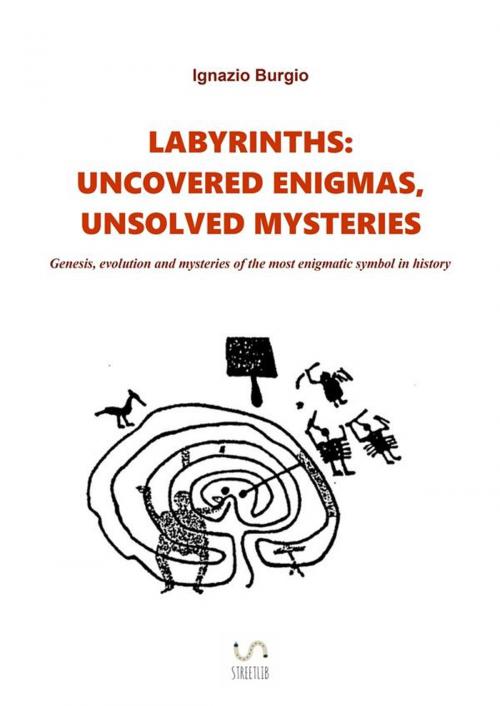Labyrinths: uncovered enigmas, unsolved mysteries
Genesis, evolution and mysteries of the most enigmatic symbol in history
Nonfiction, Art & Architecture, General Art, Art History| Author: | Ignazio Burgio | ISBN: | 9788827511091 |
| Publisher: | Ignazio Burgio | Publication: | November 6, 2017 |
| Imprint: | Language: | English |
| Author: | Ignazio Burgio |
| ISBN: | 9788827511091 |
| Publisher: | Ignazio Burgio |
| Publication: | November 6, 2017 |
| Imprint: | |
| Language: | English |
The most mysterious symbol in history, the labyrinth, can be finally unveiled by archeoastronomy, the science that studies the astronomical knowledge of the ancients and their correlations with monuments, myths, symbols, and so on.
The remains of ancient megalithic civilizations - in the British Isles, along the coasts of the Atlantic, in the Mediterranean, etc. - point out, for example, the solar nature of the "thread of Ariadne", that is, the first solar ray on the solstices that come in dolmen and burials as Newgrange to bring the dead back to life with a new reincarnation.
As evidenced by new and most accurate dating of the oldest labyrinths engraved in the rocks of the megalithic regions of the Atlantic, the figure was used as a talisman by prehistoric miners, and symbolized with its volutes and its corridors both the sun and moon cicle during the year, both the circular temple plan such as Stonehenge, and “the bowels of Mother Earth”, the underground world of the deceased and deities of the afterlife.
Heaven, Earth, Hell: the three worlds or plans of existence venerated by the ancients, and symbolically combined in many of their artistic and religious aspects, were also merged in the shape of the labyrinth. As also in the case of ancient Roman labyrinths surrounded by walls and towers designed not only to attract fortune by the souls of the ancestors in the Hades and the god of wealth Pluto (also a god of the subsoil), but to distance the danger of earthquakes, believed the wrath of the underground gods. During the founding of each city, its walls, whose doors were oriented to solstices, was in fact under the protection of the infernal deities through the same dance (the “Game of Troy”) that was performed during the funeral rites - also reproduced in the " Tragliatella jug ", which contains a famous labyrinth.
This essay deals with several other issues related to the many enigmatic aspects of labyrinths on which many scholars continue to debate: the dating of Arctic labyrinths; the archeo-astronomical significance of the ancient dances of the labyrinth; the arrival of the labyrinth in India, Indonesia and America before Columbus; the astronomical orientation of the labyrinth of Amiens, France; the viking genesis of the great labyrinths in French cathedrals; the derivation of the Renaissance garden labyrinths from the May Tree Festival; labyrinths hidden, censored, eliminated, and even bombed; and much more.
The most mysterious symbol in history, the labyrinth, can be finally unveiled by archeoastronomy, the science that studies the astronomical knowledge of the ancients and their correlations with monuments, myths, symbols, and so on.
The remains of ancient megalithic civilizations - in the British Isles, along the coasts of the Atlantic, in the Mediterranean, etc. - point out, for example, the solar nature of the "thread of Ariadne", that is, the first solar ray on the solstices that come in dolmen and burials as Newgrange to bring the dead back to life with a new reincarnation.
As evidenced by new and most accurate dating of the oldest labyrinths engraved in the rocks of the megalithic regions of the Atlantic, the figure was used as a talisman by prehistoric miners, and symbolized with its volutes and its corridors both the sun and moon cicle during the year, both the circular temple plan such as Stonehenge, and “the bowels of Mother Earth”, the underground world of the deceased and deities of the afterlife.
Heaven, Earth, Hell: the three worlds or plans of existence venerated by the ancients, and symbolically combined in many of their artistic and religious aspects, were also merged in the shape of the labyrinth. As also in the case of ancient Roman labyrinths surrounded by walls and towers designed not only to attract fortune by the souls of the ancestors in the Hades and the god of wealth Pluto (also a god of the subsoil), but to distance the danger of earthquakes, believed the wrath of the underground gods. During the founding of each city, its walls, whose doors were oriented to solstices, was in fact under the protection of the infernal deities through the same dance (the “Game of Troy”) that was performed during the funeral rites - also reproduced in the " Tragliatella jug ", which contains a famous labyrinth.
This essay deals with several other issues related to the many enigmatic aspects of labyrinths on which many scholars continue to debate: the dating of Arctic labyrinths; the archeo-astronomical significance of the ancient dances of the labyrinth; the arrival of the labyrinth in India, Indonesia and America before Columbus; the astronomical orientation of the labyrinth of Amiens, France; the viking genesis of the great labyrinths in French cathedrals; the derivation of the Renaissance garden labyrinths from the May Tree Festival; labyrinths hidden, censored, eliminated, and even bombed; and much more.















